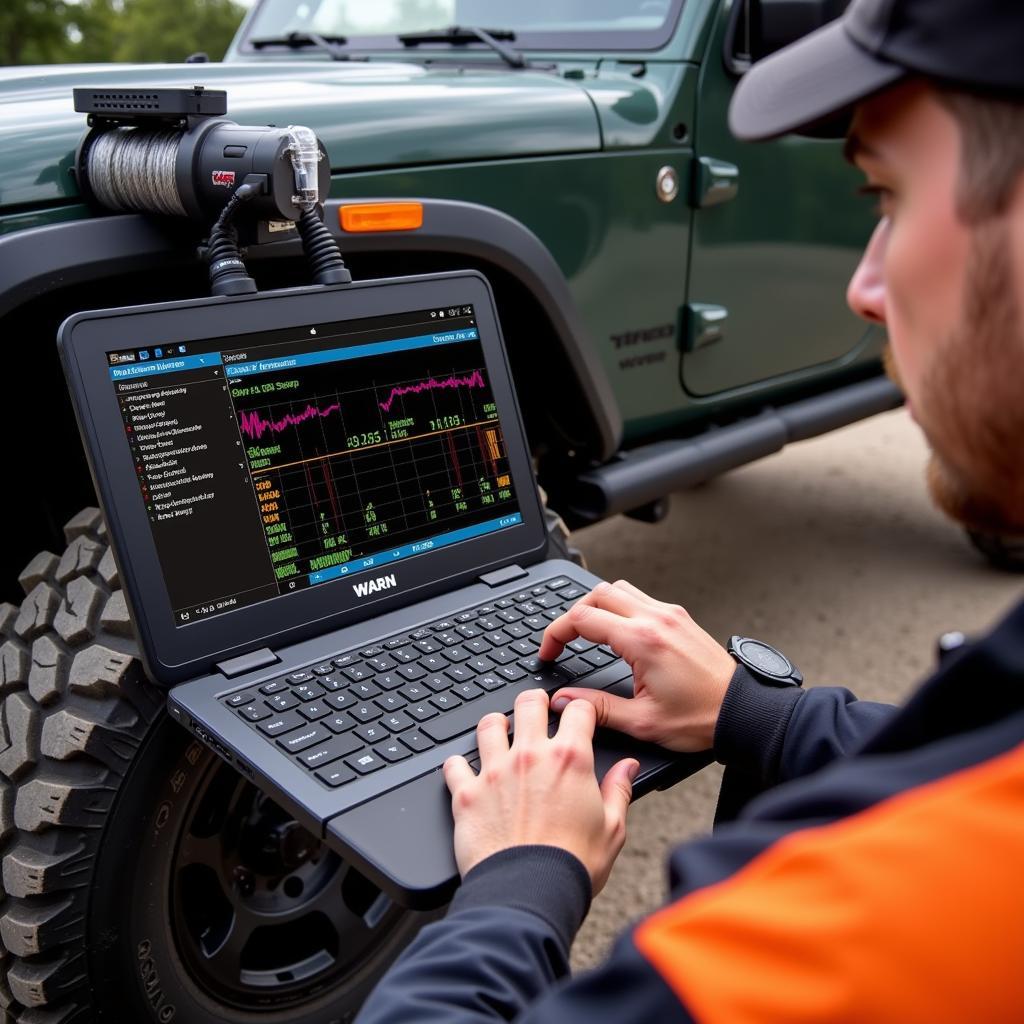A “warn winch brake down” message can bring your off-roading adventure to a screeching halt. This article delves into the common causes of winch brake malfunctions, offers troubleshooting tips, and explores the exciting possibilities of remote software solutions for fixing these issues.
Understanding the Warn Winch Brake System
Winch brakes are crucial safety components designed to hold the load securely when the winch is not actively pulling. A malfunctioning brake can lead to dangerous situations, including uncontrolled unwinding and potential injury or damage. Understanding the mechanics of your Warn winch brake is the first step in diagnosing and resolving issues. Warn winches typically use a mechanical brake system, often integrated into the winch drum. This system relies on friction to hold the load.
Common Causes of a “Warn Winch Brake Down” Warning
Several factors can trigger a “warn winch brake down” warning. These include:
- Worn Brake Components: Over time, the brake linings can wear down, reducing their effectiveness. This is especially true with frequent heavy use.
- Contamination: Mud, dirt, water, and other debris can interfere with the brake mechanism, hindering its ability to engage properly.
- Mechanical Failure: Springs, pins, or other internal components can break or become dislodged, preventing the brake from functioning correctly.
- Electrical Issues: While less common, a faulty sensor or wiring problem can also trigger a “warn winch brake down” warning.
- Software Glitches: In modern winches with integrated electronic control units (ECUs), software glitches can sometimes cause false warnings or affect brake performance.
Troubleshooting a Warn Winch Brake Issue
If you encounter a “warn winch brake down” warning, follow these steps to troubleshoot the problem:
- Consult your owner’s manual: Your Warn winch manual will provide specific instructions and safety precautions for your model.
- Inspect the winch: Carefully examine the winch drum and brake assembly for visible signs of damage, wear, or contamination.
- Test the brake manually: Attempt to free-spool the winch cable. If the cable unwinds uncontrollably, the brake is definitely malfunctioning.
- Check for electrical issues: Inspect the wiring and connections for any damage or loose connections.
- Check the error codes (if applicable): Some Warn winches have diagnostic capabilities that can provide error codes related to the brake system.
Remote Diagnostics and Software Solutions
Advances in automotive technology have brought about the possibility of remote diagnostics and software solutions for addressing winch issues. Using specialized software and diagnostic tools, technicians can connect to your winch’s ECU remotely to analyze data, identify the root cause of the problem, and potentially even apply software updates or recalibrations to fix the issue without physical intervention.
 Remote Winch Diagnostics
Remote Winch Diagnostics
How does remote winch brake diagnosis work?
Remote diagnostics typically involves connecting a diagnostic interface to the winch’s ECU and then establishing a secure connection to a remote server or a technician’s computer. This allows the technician to access real-time data from the winch, including brake performance indicators, error codes, and other relevant information.
What are the benefits of remote winch brake repair?
Remote repair offers significant advantages, including convenience, speed, and cost-effectiveness. It eliminates the need to transport your vehicle to a service center, saving you time and money. In some cases, remote software updates can resolve the issue entirely, avoiding the need for costly parts replacements.
“Remote diagnostics and software updates are game-changers in the off-roading world,” says John Smith, a Senior Automotive Electrical Engineer at Warn Industries. “They empower us to provide faster and more efficient service to our customers, getting them back on the trails quickly.”
Preventing Winch Brake Problems
Regular maintenance is key to preventing winch brake issues. This includes:
- Keeping the winch clean and lubricated: Regularly clean the winch and apply appropriate lubricants to prevent corrosion and ensure smooth operation.
- Inspecting the brake components: Periodically check the brake linings for wear and tear and replace them as needed.
- Avoiding overloading the winch: Operate the winch within its rated capacity to prevent excessive stress on the brake system.
Conclusion
A “warn winch brake down” message shouldn’t be a cause for panic. By understanding the common causes, following proper troubleshooting steps, and exploring the possibilities of remote diagnostics and software solutions, you can quickly resolve the issue and get back to enjoying your off-road adventures. Regular maintenance is essential to prevent future problems and ensure the long-term reliability of your Warn winch brake. Don’t let a faulty brake hold you back!
FAQ
- What should I do if my Warn winch brake fails while I’m using it?
- Can I repair a Warn winch brake myself?
- How much does it cost to replace a Warn winch brake?
- How often should I inspect my Warn winch brake?
- What are the signs of a worn-out Warn winch brake?
- Are remote software updates available for all Warn winch models?
- How can I find a qualified technician to perform remote diagnostics on my Warn winch?

